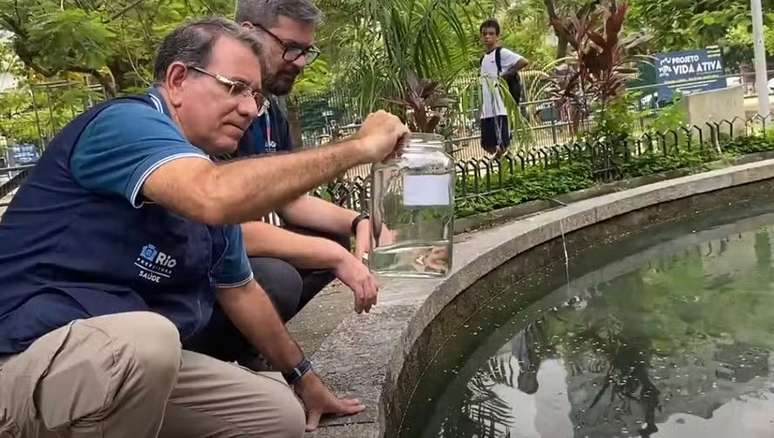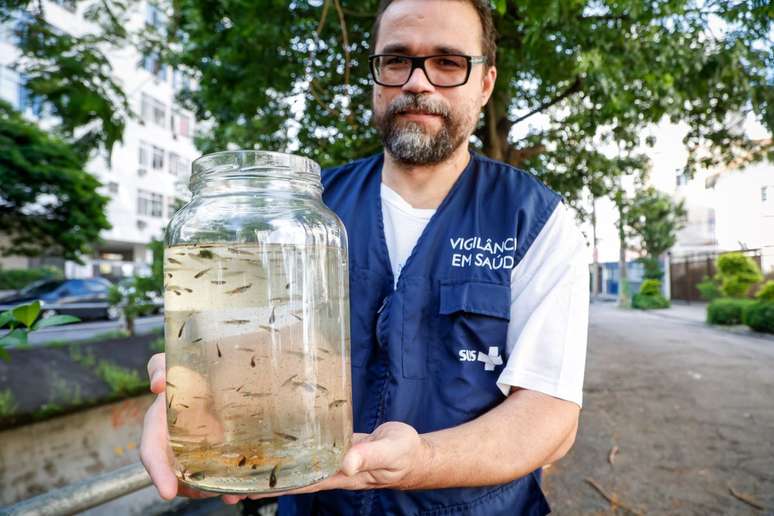Biological control strategy places pot-bellied fish in wetlands, swimming pools and basements of abandoned buildings
Summary
The fish popularly known as “barrigudinhos” are introduced into places with stagnant water and eat the larvae before they transform into dengue mosquitoes. Biological control is carried out throughout the city of Rio de Janeiro and in communities where the possibility of breeding sites is high, it makes a difference.
In abandoned or difficult to access places, such as flooded areas full of rubbish and bushes, the fish popularly called “barrigudinho” eats the larvae before they transform into mosquitoes. In Rio de Janeiro, the strategy controls the proliferation of dengue in popular regions, such as Vargem Grande, in the west, and Piedade, in the north, as well as in other areas of the city.
Before becoming a mosquito, dengue transmitters are larvae. The “belly” feeds on them, preventing them from becoming insects. Biological control does not require the application of chemicals. Another advantage is that the “bellies” are resistant to water pollution and temperature changes. In Rio slang it is a “walloon fish”, which also survives in the sewers.
Sanitation officials deposit them in places where the water cannot be removed, such as rainwater floods, fountains, abandoned works, swimming pools and water tanks. The fish proliferate rapidly and periodic visits, between 15 and 30 days, monitor the process. If necessary, more “bellies” are introduced.
Barrigudinho has been used for decades
“Not all fish feed predominantly on larvae. The belly was chosen as a method of biological control precisely because it prefers mosquito larvae to other foods”, explains the coordinator of environmental surveillance at the Municipal Health Department, Rafael Pinheiro.
Fish cannot simply be placed in natural areas, such as rivers, lakes and ponds, to prevent them from becoming predators. Rio de Janeiro has been using the method for more than three decades, citywide, making a difference in peripheral regions where conditions for the proliferation of the dengue mosquito are greatest.

Eating larvae in an abandoned water park
The Vargem Grande region, west of Rio de Janeiro, is the fastest growing, with a large amount of precarious housing. There are the favelas of Cachorro Sentado, Cascatinha, Rio Bonito and Rio Morto, among others. In Vargem Pequena, next door, you can mention the Favela da Beira do Canal and Coroados.
One of the population’s concerns is the huge abandoned water park, measuring 400,000 square metres, which has been in operation for 20 years. The Water Planet river boasted of being the largest in Latin America. It had pools, artificial rivers and rapids, slides and other attractions.
In structures abandoned since 2018, water accumulation is inevitable. But dengue does not spread, guarantees the municipal Health Department, here is one of the main creators of the city’s flat stomach.
“It makes no sense to empty and clean abandoned places. If you plan to store water again, fish helps a lot. The ideal is to have no larvae, but if there are, they should die before becoming a mosquito, interrupting the cycle,” says Geiza de Andrade Moura da Silva, a breeder from the western area, educator and activist from Marias em Ação.
In Piedade the fish eat the larvae without mercy
The Piedade region, to the north, is a typical suburb of Rio, with at least twenty favelas, such as Caixa D´Água, on the border with Quintino. Beco do Vitorino, Pau Ferro, Morro da Amália and others are nearby.

In Piedade, where Zico emerged in football, the Gama Filho University operated, the first in the suburbs of Rio, which acquired national notoriety. Closed in 2014, the property includes a swimming pool, a cause for concern among residents. But after closing the pot-bellied fish eat the larvae. The site will be transformed into a park.
The “belly” is in the affectionate memory of Mauro Poirier, originally from the western area. “As a child I loved playing with him and today he is a hero fish in the fight against dengue in the city,” says the biologist and executive director of the NGO Defensores do Planeta.
Remember that, throughout Brazil, the fish is called by names such as guaru, nereirinha, sarapintado, rainbow, guaru and bobó. His work eating dengue mosquito larvae takes place in several locations, such as Uberaba, in Minas Gerais, and Parnaíba, in Piauí.
Source: Terra
Rose James is a Gossipify movie and series reviewer known for her in-depth analysis and unique perspective on the latest releases. With a background in film studies, she provides engaging and informative reviews, and keeps readers up to date with industry trends and emerging talents.






